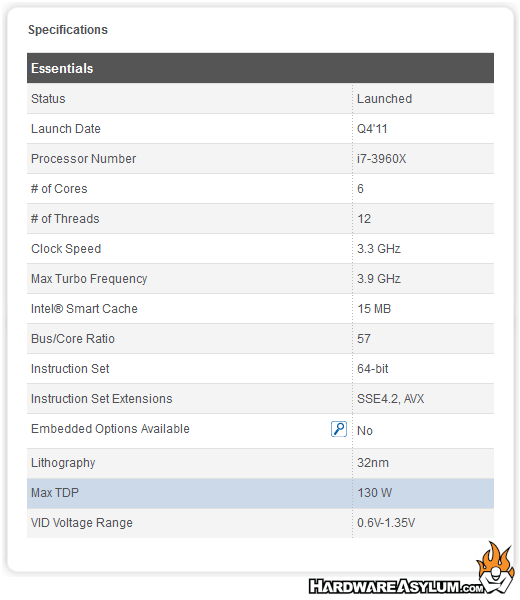Thermaltake Pacific W2 CPU Water Block Review
Author: Dennis GarciaBenchmarks
The Pacific W2 waterblock is designed for Intel Socket LGA2011 / 1156 / 1155 / 1150 and AMD processors. Here is an overview of the system and testing methodology.
Asus P9X79 - X79 Chipset
Pacific W2
Danger Den M6
Cooling Gear
Black Ice 240 2x120mm Radiator
Pacific PR22-D5 Pump + Res
Noctua NF-F12 Fans
The CPUID System Monitor was used to obtain and record system temperature data and being that this is a quad core processor we need something that will work across all of the cores at once. For this task we're using a new version of Prime95 (p95v255a) that will allow you to spawn (n) instances to test with.

Editors note: Even though the Windows 7 task manager reported 100% processor usage we could never attain a 100% of the rated heat output as documented by Intel (see below) when using Prime95 as a basis for that heat production. Knowing this we ran the stress test until the maximum temperature was attainted and stabilized.
Other things to consider when judging software induced heat output.
a) Clock throttling by the processor at high temperatures.
b) Normal software isn't designed to produce maximum heat output.
c) Variances of cooling temperature.
d) Variances in CPU load.
e) Inaccuracies in thermal diode readouts.
Of course the list goes on..
Our testing methodology is aimed to provide a real world look into this waterblock given the test system provided.

A C/W rating can quickly be calculated using this formula.
C/W = (CPU temp - Ambient temp)/(Variance(%) * CPU Watts)
Allowed variance for this test = 85%
CPU Watts = 130W
Ambient Temp = 21C
Water Temp = 26.3C
0.09 C/W = (36C – 26.3C)/(.85(130W))
For this next test the CPU speed was cranked up to 4.6Ghz and the test was re-run.

To calculate a new C/W rating for this test we will need to factor in the increased processor wattage. The formula and constants for this are listed below.
ocC/W = dCPU Watts * (ocMhz / dMhz) * (ocVcore / dVcore)2
ocMhz = 4600
dMhz = 3300
ocVcore = 1.2
dVcore = 1.375
The variance still applies for our C/W calculation
Allowed variance for this test = 85%
CPU Watts = 238W
Ambient Temp = 21C
Water Temp = 29.1C
0.12 C/W = (53C – 29.1C)/(.85(238W))
In our heatsink and waterblock tests we don't really focus on overall load temperatures but rather how well the product can remove heat given a specified heat load. Since this is a real world testing method we need to take into consideration real world variables and estimate tolerances. This is why we normally only apply 85% of the total wattage output to our heat calculations.
The resulting C/W number is used to rate how efficient a heatsink or waterblock is based on the given heat load. These numbers can be used to determine heat capacity, the larger the difference the less efficient the heatsink is. (aka not good for overclocking)
Sandy Bridge E might be a little long in the tooth but from a heat production perspective it is very accurate and repeatable. During the test I was able to pump an estimated 238w of heat into the cooling loop at 4.6Ghz and the results show that the system can handle a mild overclock quite well but started struggling given how fast the C/W number rose between tests. What I normally want to see is a reduction in C/W indicating that the block can handle more.
For these tests I also took the radiator out of the equation and used the water temperature right before it entered the waterblock to determine the C/W number. I then waited for the temperature to equalize and recorded everything at that time. Had I used a larger radiator the water temp would have been lower and so too would the CPU temp. The resulting C/W would have been the same.
Keep in mind these calculations are provided for demonstration purposes only and may not reflect the actual lab tested C/W rating, but we're pretty close.

